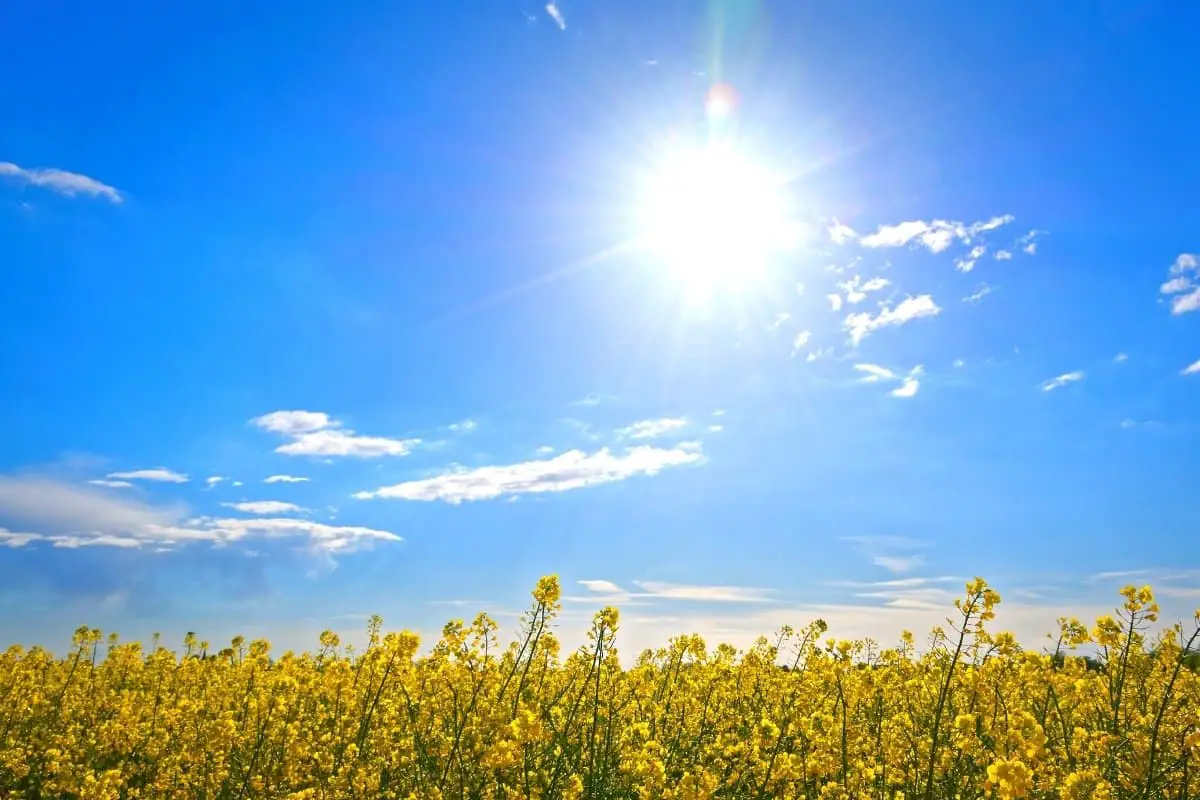Last Updated on March 2, 2023 by Griselda M.
When is the hottest part of the day? Ask anyone this, and they will be quick to say noontime or 1 pm is the hottest time of the day.
Determining the hottest time of day largely depends on the time of year. It also depends on where you are located on this planet earth. This is because weather patterns vary from place to place.
The Earth receives the sun at different times of the day, creating a variety of time zones. The rays from the sun heat the planet the same way a burner on a stove boils water. Even though you set the burner on high fire, it takes a while for the water to boil. The same concept is valid with the temperature of the day.
What is The Hottest Part of The Day?
There is a misconception among most people believing that the warmest time of the day is noon. It may feel hotter at noontime simply because we are getting the most energy from the sun at that time.
However, it is different from the planet Earth. As the day gets hotter, the Earth stores the incoming energy or heat throughout the day. The longer the sun is out, the hotter the air becomes.

Temperatures keep climbing as long as the Earth receives more incoming heat than it released back into space. The re-radiation takes place later, making the hottest part of the day between 3 pm and 6 pm during the summer.
During the morning hours, the temperatures warm very quickly because of the mixing of 2 air masses. Over the night, the cooler air sinks to the valley from the mountains.
As the sun rises in the morning, solar radiation starts to heat the ground. The 2 air masses’ difference in temperature creates turbulence which results in a quick warm-up.
What Determines The Hottest Time of The Day?
The hottest time of day is determined by some factors that include,
Direct sunlight
The sun is at its highest point, approximately noon. The sun’s high point is when it gives the Earth the solar noon, the most direct sunlight.
At this point, a sunburn will quickly occur in the shortest amount of time due to the direct sunlight. At this time, the sun’s radiation is the strongest; however, even though it is, its temperature is still not the hottest.
Diurnal cycle
The diurnal cycle is the rotation of the Earth on its axis, creating night and day. The diurnal cycle is the effect that creates a delay in temperature increase on the Earth’s surface known as the thermal response.
Between the times the sun provides the Earth with the most direct sunlight and when the temperature rises, the National Climatic Data Center estimates a 3 to 4-hour delay.
Read more about A Guide To Birds Behavior Before A Storm
Thermal response
This process begins at solar noon when the surface of the Earth starts to heat. As long as the Earth receives more heat than it sends to space, the temperature continues to climb. Generally, there is a delay between the solar noon and the hottest time or the thermal response.
During the summer, the hottest part of the day is usually between 3 pm and 4:30 pm, depending on the wind speed and the cloud cover.
Variables
The hottest part of the day is determined by different variables. Depending on the time of the year, if your part of the country recognizes daylight savings time, the hottest part of the day will be increased or decreased by an hour.
The season will also make a difference because of the climatic changes occurring during the winter. Many times, the cold fronts decrease the temperature all day long during this time of the year.
ThermoPro TP62 Indoor Outdoor Thermometer Wireless Weather Hygrometer
Your location also determines what time of the day is the hottest. In this winter weather, the hottest part of the day can be in the early morning. A cold front can later follow in the afternoon, cooling down the surface of the Earth. The climatic changes can affect one part of the country or the Earth, while another is not affected.
Click Here to Know Beautiful Flowers:
Important Information to Note
Although it is easy for most people to assume the hottest time of the day occurs when the sun is projecting the most beams onto the Earth, this is not the case.
As with other concepts that center around the idea of heat, this is not a process that unfolds quickly. It also takes time to reach its warmest temperature. Thermal response and solar radiation make it easier to understand the temperature patterns and why these behave in such a manner.
Somehow many suggest that the coldest time of the day is late-night, at around midnight, but this is not the case. Even though the sun rises early morning, the temperatures remain colder at this point as the Earth is yet to warm up.
Both the hottest part of the day and the coldest time are affected almost by the same factors of time and the radiation process.

Surprisingly the coldest time of the day happens way later than many would expect, and as we have mentioned, it occurs shortly after the hottest time of the day.
There are specific factors that make it hard to identify a particular time of the day, especially when it is the coldest. However, it is likely to be around one to two hours after the hottest time of the day.
There are scientific explanations behind the delays of temperatures as they rise and they fall. It is important to note that differences can be witnessed depending on your location and the weather pattern that you experience.
What Time is the Hottest Part of the Day in Australia?
Have you ever wondered what time is the hottest part of the day in Australia? Some of the highest known temperatures recorded in Australia have reached up to 50 C. However, it is simple to determine when the sun is striking at its highest levels in the day because of the thickened air and other elements that play a vital role in temperatures.
From research, the hottest time of the day is between 3 pm and 4 pm in Australia. The build-up to the heat starts at around noon and thrives if there are no disturbances from other natural weather occurrences. This means that the sun’s force continues to bake the earth with its ray while small portions of heat escape. By 3 pm, it would be evident that the arrival of heat marginally outweighs its departure from the earth’s surface.
Therefore, it is accurate to state the hottest part of the day in Australia as 3 pm, as it is evident. In cases where the afternoon gets cooler because of systematic weather changes, then midday can be considered to have the highest temperatures in this instance. So, when does it start warming up? Generally, angry summer, or extreme summer as it is known in Australia, see’s average summer highs of about 39 C daily, which starts to warm up before midday.
Hottest Time of the Day in South Africa
The hottest time of the day in South Africa is around 3 pm or so. This is because when the sun is at its highest point in the sky after midday, the heat continues to increase and build up toward the afternoon. By the time it reaches 3 pm when the sun has moved lower, incoming heat becomes much greater than outgoing. Compared to other provinces in Sothern Africa, Durban experiences extremely warm weather, season after season.
This is because the city falls on the east coast of Kwa-Zulu Natal and is privileged to have the warm Indian Ocean at its doorstep. Although there have been uncomfortable temperature highs of 50 C that were previously recorded, the city of Durban usually has exceptional weather that is enjoyed throughout the year.
What is the Hottest Time of the Day in California?
If you’re wondering what is the hottest time of the day in California, then the following information is for you. Many people believe that the hottest part of the day is at noon, which is a common misconception for the most part. I say this because it would be several hours later that California would actually feel the brunt of the sun’s force on a hot summer’s day.
To answer the question above, the hottest part of the day in California can be felt between 3 pm and 4:30 pm. However, this will depend on a few factors. If there is no interference from other natural elements like cloud cover, rain, and wind speed, you can expect to feel the rays of the sun at full throttle in the said timeframe.
What most of us mistake as the hottest time of day is when the earth receives an increase in solar radiation at midday. Although this is a fact, it doesn’t mean that this is the warmest part of the day unless the afternoon wind speed and cloud formation have substantially increased. So, to put things into perspective, you should expect to feel the full warmth of the sun’s rays about three to five hours after midday in the California region.
Conclusion
Science is complicated, and only with many studies can we break it down to our level of understanding. The information has been broken down so well to help every person understand it and relate to it the best way they want to.
If you are a gardener who wanted to know when is the hottest part of the day so that you don’t transplant at that time, now you do. And if you are a hiker and want to avoid the hottest part of the day outdoors, now you know how to read the weather in your region.
FAQs
Where is the best place to plant pansy?
You can plant pansies in the ground as long as they are at least one year old. They like a sunny location with average soil, but they don't require much fertilizer or water. The seedlings will not be very large and can be transplanted into larger pots or the garden in their second year. When planting pansies in the ground, don't cover the roots with soil.
Can pansies handle full shade?
Pansies need to be in full sun to grow. My mom has one in the garden and she's told me that it won't survive full shade. I've heard that it will survive if you keep it near a window, but that doesn't sound like a good idea because the window gets too hot.
When can I put my pansies outside?
It's late August and it's time to start thinking about your fall planting. Now is the time to start thinking about what you want to do with your pansies in the coming months. In general, it is best to plant pansies when soil temperatures are above 50 degrees Fahrenheit (10 degrees Celsius) because they need this warm temperature for proper growth.
Pansies prefer a soil that is moist but not soggy and acidic, which is why they like to be planted in well-draining soils. When you plant your pansies, make sure they are planted in rows or in groups of two or three so they have room to grow. Pansies will grow quickly and often bloom multiple times from one plant. Pansies can be grown as annuals, biennials, or perennials.
What do I do with potted pansies in the summer?
Take the plants out of the pots and bring them into a cool location for a couple weeks. Then bring them back inside where they will be protected from the heat. If you don't have a cool location, then bring them inside until fall.
Can it get too hot for pansies?
Yes, it can get too hot for pansies. When it gets over 85 degrees F outside, the pansies should be in the shade or in a shaded area. If it is really hot, I would suggest moving them to a cooler place, like a basement, or even in an air-conditioned room. You don't want to take any chances with your pansies!
Caroline is a gardener who loves to get down to the nitty–gritty of gardening. She proudly proclaims herself as a ‘dirt worshipper‘ and can often be found deep in the garden, covered in soil and singing to her plants. As a self–proclaimed ‘plant whisperer‘, Caroline believes that plants need love and attention just like any other living thing, and she loves to give them both. When she‘s not tending to her garden, you can often find her researching the latest gardening trends, or teaching others how to make their gardens thrive




